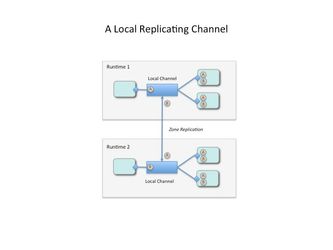...
| Code Block | ||||
|---|---|---|---|---|
| ||||
<composite xmlns:f3="urn:fabric3.org" ...> <channel name="SomeChannel" requires="f3:replication"/> <composite> |
Cluster Replication
...
In this scenario, events emitted by the producers on both runtimes will be received by all consumers connected to the channel in the zone. The following figure illustrates event replication:
Remote Channels
A channel is considered remote in two cases:
- The channel is configured with a binding
- The channel is deployed in a different zone than connected producers and consumers
Bound Channels
If a channel is configured with a binding, events sent by connected producers will be dispatched to the remote transport specified by the binding, regardless of whether the producer is in the same zone as the channel. Explicitly configuring a channel binding in this way is useful when events need to be observed by a system that is external to the SCA domain. Configuring a channel binding is also useful when external events need to be observed by an SCA consumer. In this case, a bound channel will listen on a remote transport and forward events sent by remote systems to connected consumers.
...
Remote Producers and Consumers
This allows events to be sent across clusters. Bindings are configured in the same way as references.
If no bindings are specified and a producer is defined in a composite that is deployed to a different cluster (zone) than a channel, Fabric3 will automatically create a remote binding between the two. For example, if the BuyComponent in the previous example were deployed to a different cluster than the BuyChannel, Fabric3 will generate a remote binding to propagate messages from the producer component to the channel.
